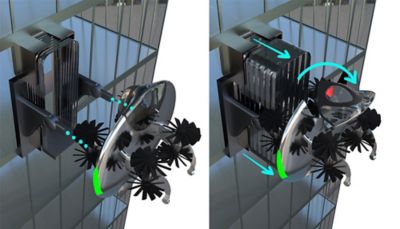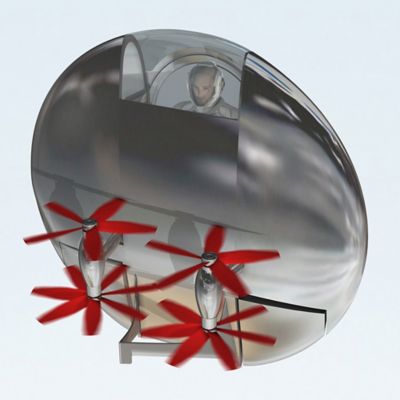ANSYS BLOG
March 1, 2019
Forget Jet Packs or Flying Cars! Design a Personal Flying Device!
If you ever wanted to fly around like George Jetson, then you might want to get in contact with ZEVA AERO (ZEVA). The Ansys Startup Program member has designed a personal flying device, the ZERO, which is reminiscent of Hanna Barbera’s flying car from the year 2062.
The ZERO is designed for electric vertical takeoff and landing (eVTOL).
Rendering of ZEVA AERO’s ZERO Personal Flying device
Since the vehicle can take off and land in tight spots, it makes ZERO a great option for city flying, rescue operations and defense.
Currently, ZEVA is ramping up remote testing of the aircraft — with pilot trials to start shortly. Thanks to Ansys simulation software, ZEVA is confident that its tests will be a success.
ZEVA also hopes that these tests will be the first step to breaking into the personal flying device market and winning the Boeing sponsored GoFly Prize of a million dollars.
How the ZERO Personal Flying Device Works
The ZERO’s eVTOL functionality enables the transition from a vertical start to the travel mode — which is near horizontal. During liftoff, it flies similarly to a small quadcopter drone. This makes it perfectly suited for emergency, city and defense flying in dense environments.
ZERO’s eVTOL transitions it from a vertical into a near horizontal travel mode.
However, until urban flight equipment certification rolls out — which ZEVA suspects will be around 2025 — it aims to market the ZERO to first responders, enthusiasts and defense markets.
Key design attributes of the ZERO are that it’s quiet, fast and energy efficient. To participate in GoFly, it must operate under 86 decibels, fly 50 feet high and lap a 1 nautical-mile course six times with battery power to spare. The ZERO can fly about 40 nautical miles at 100 mph on a single charge.
The ZERO also has a wide cone of visibility. GoFly regulates that the cone of visibility must be unobstructed and 90 degrees. ZERO offers an unobstructed view of 104 degrees.
Parking the ZERO Personal Flight Vehicle
So where will pilots park the ZERO? It’s not like it can fold into a briefcase upon arrival, like George Jetson’s aerocar.
Instead, the ZERO can land in an outside parking lot. One requirement to GoFly is that the vehicle needs to fit within an 8.5-foot sphere. As a result, it can fit inside a standard parking spot.
The ZERO is small enough to fit in a parking spot,but it can
also dock to a building.
Additionally, ZERO will connect to a patent-pending SkyDock. The SkyDock can be installed on the sides of buildings and connected directly to an office or residence. So, the parking experience is less George Jetson and more Tony Stark.
Parking the ZERO will also be simplified so most pilots will be able to fly the device. In fact, ZEVA aims to have the docking and parking procedures computer-controlled. This will take human error out of the mix.
The benefit of the SkyDock is that it will leave the roof clear for emergency vehicles/egress, air taxis, maintenance shacks and solar panels. ZEVA suspects the SkyDock will be very useful in cities with high population densities such as Hong Kong and Shanghai.
Designing the ZERO Personal Flying Device
Currently, ZEVA uses Ansys computational fluid dynamics (CFD) software to test the ZERO in a digital wind tunnel. These simulations help optimize the vehicle’s aerodynamics under various altitudes and environmental conditions.
“Ansys simulations were instrumental to test our theories,” says Stephen Tibbitts, chairman and CEO of ZEVA AERO. “We took different shapes and compared them for lift and drag under different angles of attack.
Rendering of a pilot flying the Zero Personal Flying Device
Since the vehicle starts in a vertical position and transitions to a travel mode, we need to understand the drag at each angle of attack.”
“We used aerospace best practices to come up with shapes for the ZERO. We then validated them with CFD simulations. If we found issues with the design, as we added components or changed things up, the Ansys simulation would provide feedback so we would know to use that change or not.”
As ZEVA nails down its design for the ZERO, it will begin to use Ansys simulation technology to test other aspects of its design — from accident safety to battery optimization and noise control.
If you are a startup and would like to use Ansys simulation technology to design your product, join the Ansys Startup Program.



